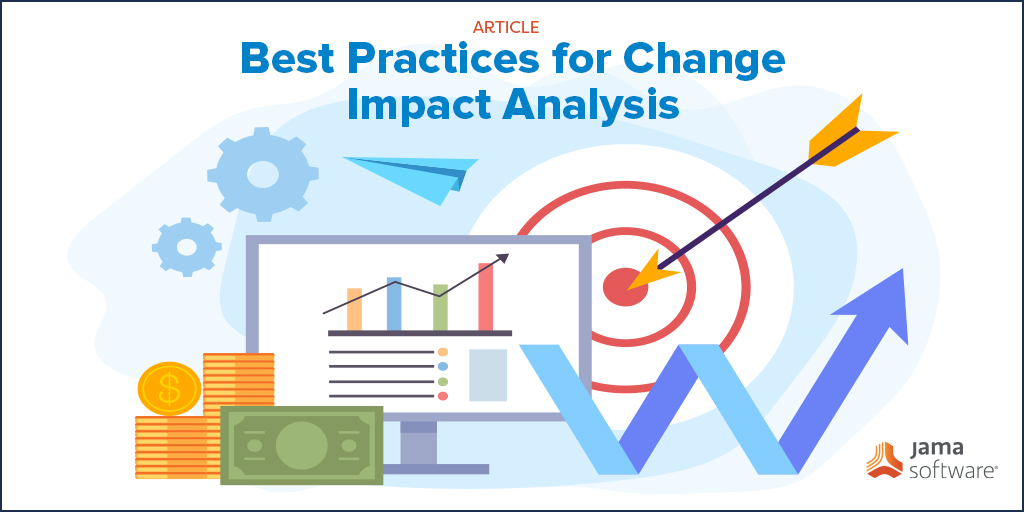
Best Practices for Change Impact Analysis
Impact analysis is a key aspect of responsible requirements management. It provides an accurate understanding of the implications of a proposed change, which helps the teams make informed business decisions about which proposals to approve.
The analysis examines the proposed change to identify components that might have to be created, modified, or discarded and to estimate the effort associated with implementing the change.
Skipping impact analysis doesn’t change the size of the task. It just turns the size into a surprise. In product development surprises are rarely good news. Before a developer says, “Sure, no problem” in response to a change request, he or she should spend a little time on impact analysis.
RELATED: A Guide to Good Systems Engineering Best Practices: The Basics and Beyond
Impact Analysis Procedure
Impact analysis has three aspects:
- Understand the possible implications of making the change. Change often produces a large ripple effect. Stuffing too much functionality into a product can reduce its performance to unacceptable levels.
- Identify all the files, models, and documents that might have to be modified if the team incorporates the requested change.
- Identify the tasks required to implement the change, and estimate the effort needed to complete those tasks.
Traceability data that links the affected requirement to other downstream deliverables helps greatly with impact analysis. On complex projects with thousands of artifacts, to manually determine what and who is affected by a change is time-consuming and error-prone. Alternatively, you could adopt a product development solution like Jama Connect, which includes built-in functionality for end-to-end traceability and impact analysis, and automatically highlights the items and people that are impacted when a change occurs.
RELATED: When Evaluating Product Development Software Tools, Not All Cloud is Equal
Whichever route you take, understanding the impact enables teams to quickly and accurately respond to change requests. The team can be responsive while maintaining control over the scope and customer expectations.
Lastly, impact analysis is essential on projects where quality and safety are an issue such as in healthcare, automotive, and aerospace projects. In these situations, it’s critical to understand the specific set of requirements and features that need to be retested after a change is implemented.
Steps in a typical impact analysis process look like this:
- Identify the sequence in which the tasks must be performed and how they can be interleaved with currently planned tasks.
- Determine whether the change is on the project’s critical path. If a task on the critical path slips, the project’s completion date will slip. Every change consumes resources, but if you can plan a change to avoid affecting tasks that are currently on the critical path, the change won’t cause the entire project to slip.
- Estimate the impact of the proposed change on the project’s schedule and cost.
- Evaluate the change’s priority by estimating the relative benefit, penalty, cost, and technical risk compared to other discretionary requirements.
- Report the impact analysis results to all stakeholders so that they can use the information to help them decide whether to approve or reject the change request.
In most cases, this procedure shouldn’t take more than a couple of hours to complete. This may seem like a lot of time to a busy developer, but it’s a small investment in making sure the project wisely invests its limited resources. If you can adequately assess the impact of a change without such a systematic evaluation, go right ahead; just make sure you aren’t stepping into quicksand.
RELATED: A Guide to Good Systems Engineering Best Practices: The Basics and Beyond
Money Down the Drain
What can happen if you don’t take the time to perform impact analysis before diving into implementing a significant change request?
Imagine two developers on your team estimate that it will take four weeks to add an enhancement to one of your product lines. The customer approves the estimate, and the developers set to work. After two months, the enhancement is only about half done and the customer loses patience: “If I’d known how long this was really going to take and how much it was going to cost, I wouldn’t have approved it. Let’s forget the whole thing.”
In the rush to gain approval and begin implementation, the developers didn’t do enough impact analysis to develop a reliable estimate that would let the customer make an appropriate business decision. Consequently, you waste several hundred hours of work that could have been avoided by spending a few hours on an up-front impact analysis.
Learn how a requirements management solution eliminates many of the budget-draining headaches of product development in Karl Wiegers’ paper, “Getting the Most from a Requirements Management Tool.”
 Impact analysis is the assessment of the implications of changes, in the specific context of product development. It is integral to requirements management, as it offers insights into dependencies and gaps in coverage, which help inform decisions about the product’s lifecycle.
Impact analysis is the assessment of the implications of changes, in the specific context of product development. It is integral to requirements management, as it offers insights into dependencies and gaps in coverage, which help inform decisions about the product’s lifecycle.